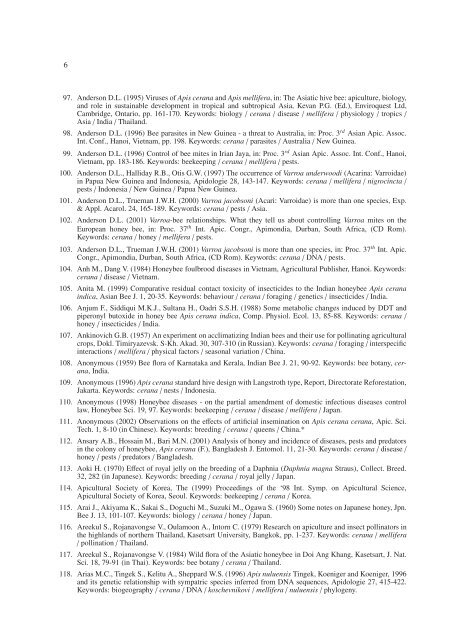Bibliography of Apis cerana Fabricius - Apidologie
Bibliography of Apis cerana Fabricius - Apidologie
Bibliography of Apis cerana Fabricius - Apidologie
Create successful ePaper yourself
Turn your PDF publications into a flip-book with our unique Google optimized e-Paper software.
6<br />
97. Anderson D.L. (1995) Viruses <strong>of</strong> <strong>Apis</strong> <strong>cerana</strong> and <strong>Apis</strong> mellifera, in: The Asiatic hive bee: apiculture, biology,<br />
and role in sustainable development in tropical and subtropical Asia, Kevan P.G. (Ed.), Enviroquest Ltd,<br />
Cambridge, Ontario, pp. 161-170. Keywords: biology / <strong>cerana</strong> / disease / mellifera / physiology / tropics /<br />
Asia / India / Thailand.<br />
98. Anderson D.L. (1996) Bee parasites in New Guinea - a threat to Australia, in: Proc. 3rd Asian Apic. Assoc.<br />
Int. Conf., Hanoi, Vietnam, pp. 198. Keywords: <strong>cerana</strong> / parasites / Australia / New Guinea.<br />
99. Anderson D.L. (1996) Control <strong>of</strong> bee mites in Irian Jaya, in: Proc. 3rd Asian Apic. Assoc. Int. Conf., Hanoi,<br />
Vietnam, pp. 183-186. Keywords: beekeeping / <strong>cerana</strong> / mellifera / pests.<br />
100. Anderson D.L., Halliday R.B., Otis G.W. (1997) The occurrence <strong>of</strong> Varroa underwoodi (Acarina: Varroidae)<br />
in Papua New Guinea and Indonesia, <strong>Apidologie</strong> 28, 143-147. Keywords: <strong>cerana</strong> / mellifera / nigrocincta /<br />
pests / Indonesia / New Guinea / Papua New Guinea.<br />
101. Anderson D.L., Trueman J.W.H. (2000) Varroa jacobsoni (Acari: Varroidae) is more than one species, Exp.<br />
& Appl. Acarol. 24, 165-189. Keywords: <strong>cerana</strong> / pests / Asia.<br />
102. Anderson D.L. (2001) Varroa-bee relationships. What they tell us about controlling Varroa mites on the<br />
European honey bee, in: Proc. 37th Int. Apic. Congr., Apimondia, Durban, South Africa, (CD Rom).<br />
Keywords: <strong>cerana</strong> / honey / mellifera / pests.<br />
103. Anderson D.L., Trueman J.W.H. (2001) Varroa jacobsoni is more than one species, in: Proc. 37th Int. Apic.<br />
Congr., Apimondia, Durban, South Africa, (CD Rom). Keywords: <strong>cerana</strong> / DNA / pests.<br />
104. Anh M., Dang V. (1984) Honeybee foulbrood diseases in Vietnam, Agricultural Publisher, Hanoi. Keywords:<br />
<strong>cerana</strong> / disease / Vietnam.<br />
105. Anita M. (1999) Comparative residual contact toxicity <strong>of</strong> insecticides to the Indian honeybee <strong>Apis</strong> <strong>cerana</strong><br />
indica, Asian Bee J. 1, 20-35. Keywords: behaviour / <strong>cerana</strong> / foraging / genetics / insecticides / India.<br />
106. Anjum F., Siddiqui M.K.J., Sultana H., Oadri S.S.H. (1988) Some metabolic changes induced by DDT and<br />
piperonyl butoxide in honey bee <strong>Apis</strong> <strong>cerana</strong> indica, Comp. Physiol. Ecol. 13, 85-88. Keywords: <strong>cerana</strong> /<br />
honey / insecticides / India.<br />
107. Ankinovich G.B. (1957) An experiment on acclimatizing Indian bees and their use for pollinating agricultural<br />
crops, Dokl. Timiryazevsk. S-Kh. Akad. 30, 307-310 (in Russian). Keywords: <strong>cerana</strong> / foraging / interspecific<br />
interactions / mellifera / physical factors / seasonal variation / China.<br />
108. Anonymous (1959) Bee flora <strong>of</strong> Karnataka and Kerala, Indian Bee J. 21, 90-92. Keywords: bee botany, <strong>cerana</strong>,<br />
India.<br />
109. Anonymous (1996) <strong>Apis</strong> <strong>cerana</strong> standard hive design with Langstroth type, Report, Directorate Reforestation,<br />
Jakarta. Keywords: <strong>cerana</strong> / nests / Indonesia.<br />
110. Anonymous (1998) Honeybee diseases - on the partial amendment <strong>of</strong> domestic infectious diseases control<br />
law, Honeybee Sci. 19, 97. Keywords: beekeeping / <strong>cerana</strong> / disease / mellifera / Japan.<br />
111. Anonymous (2002) Observations on the effects <strong>of</strong> artificial insemination on <strong>Apis</strong> <strong>cerana</strong> <strong>cerana</strong>, Apic.Sci.<br />
Tech. 1, 8-10 (in Chinese). Keywords: breeding / <strong>cerana</strong> / queens / China.*<br />
112. Ansary A.B., Hossain M., Bari M.N. (2001) Analysis <strong>of</strong> honey and incidence <strong>of</strong> diseases, pests and predators<br />
in the colony <strong>of</strong> honeybee, <strong>Apis</strong> <strong>cerana</strong> (F.), Bangladesh J. Entomol. 11, 21-30. Keywords: <strong>cerana</strong> / disease /<br />
honey / pests / predators / Bangladesh.<br />
113. Aoki H. (1970) Effect <strong>of</strong> royal jelly on the breeding <strong>of</strong> a Daphnia (Daphnia magna Straus), Collect. Breed.<br />
32, 282 (in Japanese). Keywords: breeding / <strong>cerana</strong> / royal jelly / Japan.<br />
114. Apicultural Society <strong>of</strong> Korea, The (1999) Proceedings <strong>of</strong> the ‘98 Int. Symp. on Apicultural Science,<br />
Apicultural Society <strong>of</strong> Korea, Seoul. Keywords: beekeeping / <strong>cerana</strong> / Korea.<br />
115. Arai J., Akiyama K., Sakai S., Doguchi M., Suzuki M., Ogawa S. (1960) Some notes on Japanese honey, Jpn.<br />
Bee J. 13, 101-107. Keywords: biology / <strong>cerana</strong> / honey / Japan.<br />
116. Areekul S., Rojanavongse V., Oulamoon A., Intorn C. (1979) Research on apiculture and insect pollinators in<br />
the highlands <strong>of</strong> northern Thailand, Kasetsart University, Bangkok, pp. 1-237. Keywords: <strong>cerana</strong> / mellifera<br />
/ pollination / Thailand.<br />
117. Areekul S., Rojanavongse V. (1984) Wild flora <strong>of</strong> the Asiatic honeybee in Doi Ang Khang, Kasetsart, J. Nat.<br />
Sci. 18, 79-91 (in Thai). Keywords: bee botany / <strong>cerana</strong> / Thailand.<br />
118. Arias M.C., Tingek S., Kelitu A., Sheppard W.S. (1996) <strong>Apis</strong> nuluensis Tingek, Koeniger and Koeniger, 1996<br />
and its genetic relationship with sympatric species inferred from DNA sequences, <strong>Apidologie</strong> 27, 415-422.<br />
Keywords: biogeography / <strong>cerana</strong> / DNA / koschevnikovi / mellifera / nuluensis / phylogeny.




